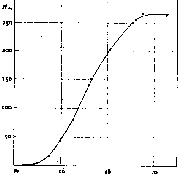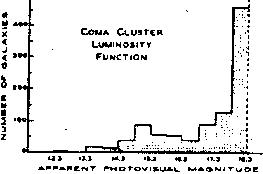


The "missing mass" problem has always rather been a "missing light" problem. Here I review the progress done in the estimation of the luminosity function (hereafter LF) of Coma in the optical. Coma's LF has also been determined in several other bands, in the radio (e.g. Willson [158], Gavazzi et al. [53], Venturi et al. [146]), in the IR (Gavazzi et al. [54]), in the UV (Donas et al. [38]). Anyway, the determination of these non-optical LFs is quite recent, so I will not consider them in my review. I refer the reader to the contributions of De Propris, Gavazzi and Mobasher in these proceedings.

|
Figure 8. Cumulative counts of nebulae in the central region of Coma vs. the photographic magnitude. In this figure, magnitudes range from 14 to slightly more than 20, and counts from 0 to slightly more than 250 - from Hubble & Humason. |

|
Figure 9. Differential LF of Coma galaxies. Magnitudes (on the x-axis) range from 12.3 to 18.3, counts (on the y-axis) range from 0 to 500 - from Sky & Telescope, XVIII, 495 (1959). |
The first determination of the Coma LF was done by Hubble & Humason.
The LF was found to peak at mph
 17 (see
Fig. 8). Twenty years later, Zwicky
[166] found
instead
17 (see
Fig. 8). Twenty years later, Zwicky
[166] found
instead
...that the luminosity function of the Coma cluster galaxies is monotonely increasing with decreasing brightness
and it took eight years more for Abell [1] to show that in fact, both Hubble and Zwicky were right, since the LF of Coma has a secondary maximum at bright magnitudes (see Fig. 9).
The complex form of Coma LF was known since 1959, yet since Schechter [118] proposed his analytical form for the cluster LF, any bump or irregularity in the observed LFs tended to be overlooked (6). Many re-discoveries of this secondary maximum in the LF were needed before astronomers start recognizing that some cluster LFs are not well fitted by Schechter [118]'s function.
The first one to re-discover (or confirm) the secondary maximum was Rood [112], 10 years later; then followed Godwin & Peach [58], in the late 70's, Thompson & Gregory [135] in 1993, and finally Biviano et al. [15] who closed this issue, by using only spectroscopically confirmed cluster members from a complete galaxy sample.
New data allowed Rood [112] to show that the LF is not the same for galaxies in the inner and outer regions of Coma. The secondary maximum looked more pronounced in the LF of galaxies in the inner region, where the fraction of bright galaxies is higher. This result was confirmed by Lugger [87], [88], 10 years after (despite the opposite conclusions reached by Gregory & Tifft [62]).
Numerical simulations allowed White [155] to show that dynamical friction can lead to the segregation of brighter galaxies in the cluster centre, and a modification of the inner LF. New simulations of Roos & Aarseth [117] showed that also merging can significantly affect the LF of galaxies in the centre of Coma.
The increase of Coma's LF at faint magnitudes seemed not to be
strong enough to
provide all the "missing light"; galaxies fainter than mpv =
18.3 only contribute ~ 13 % of the total cluster light (Abell
[4]).
However, deeper observations were to indicate a further steepening of the LF.
First, Abell [5]
showed that
at magnitudes fainter than than mv = 17.5, the LF had an asymptotic
slope (7)
 = - 1.4. Then, using
Godwin et al. [57]'s
new catalogue,
Metcalfe [95]
determined an even steeper
slope (
= - 1.4. Then, using
Godwin et al. [57]'s
new catalogue,
Metcalfe [95]
determined an even steeper
slope ( = - 1.9) for the LF at
b
= - 1.9) for the LF at
b  19.74. With such a steep
slope, the faint galaxy contribution to the total cluster light is
significant, ~ 20 %. Metcalfe's result anticipated recent findings by
Lobo et al.
[86]
(who find
19.74. With such a steep
slope, the faint galaxy contribution to the total cluster light is
significant, ~ 20 %. Metcalfe's result anticipated recent findings by
Lobo et al.
[86]
(who find
 = - 1.8;
see also the contributions of Adami, Lobo, and Sekiguchi in these proceedings).
Other evidences for a (more or less) steep LF at the faint end came from
Karachentsev et al.
[76]
and Bernstein et al.
[14].
= - 1.8;
see also the contributions of Adami, Lobo, and Sekiguchi in these proceedings).
Other evidences for a (more or less) steep LF at the faint end came from
Karachentsev et al.
[76]
and Bernstein et al.
[14].
6 This is a further proof of the skill of
astronomers in fitting a straight line to a circle!
Back.